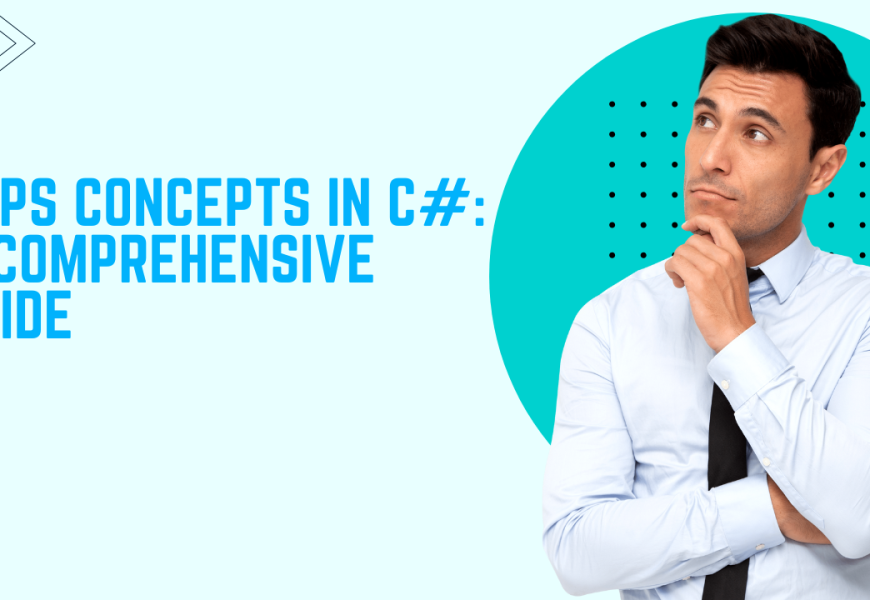When diving into the world of C#, one cannot overlook the importance of the oops concepts in C#. Understanding these concepts is crucial for any aspiring developer, as they form the backbone of object-oriented programming (OOP). In this article, we’ll explore the fundamental principles of OOP, demonstrate their implementation in C#, and provide examples that make these concepts easy to grasp. If you’re ready to deepen your understanding, let’s embark on this enlightening journey!
What Are OOP Concepts?
Before we dive into the specifics of C#, let’s take a moment to understand what OOP concepts are all about. Object-oriented programming revolves around four key principles: Encapsulation, Abstraction, Inheritance, and Polymorphism. These principles help in organizing code efficiently, making it more reusable and easier to manage.
Encapsulation: The Foundation of OOP
Encapsulation is about bundling the data and methods that operate on that data within one unit, typically a class. This principle restricts direct access to some components, which can prevent the accidental modification of data.
Why Encapsulation Matters
Encapsulation enhances security by hiding the internal state of an object from the outside world. This means that you can control how data is accessed and modified. Here’s a simple example in C#:
csharp
Copy code
public class BankAccount
{
private decimal balance;
public void Deposit(decimal amount)
{
if (amount > 0)
{
balance += amount;
}
}
public decimal GetBalance()
{
return balance;
}
}
In this example, the balance variable is private, ensuring it can only be modified through the Deposit method, safeguarding the integrity of the account.
Abstraction: Simplifying Complexities
Abstraction allows you to hide complex implementation details and expose only the necessary parts of an object. This makes it easier to interact with the object without needing to understand the complexity behind it.
How to Implement Abstraction in C#
In C#, abstraction can be achieved using abstract classes and interfaces. For example:
csharp
Copy code
public abstract class Animal
{
public abstract void MakeSound();
}
public class Dog : Animal
{
public override void MakeSound()
{
Console.WriteLine(“Woof!”);
}
}
In this case, Animal serves as an abstract class, and Dog implements the specific sound behavior. Users can interact with the Animal type without worrying about the underlying details.
Inheritance: Building on the Past
Inheritance allows one class to inherit the properties and methods of another class. This promotes code reusability and establishes a hierarchical relationship between classes.
Example of Inheritance in C#
Here’s how you can implement inheritance:
csharp
Copy code
public class Vehicle
{
public void Start()
{
Console.WriteLine(“Vehicle started.”);
}
}
public class Car : Vehicle
{
public void Drive()
{
Console.WriteLine(“Car is driving.”);
}
}
In this example, Car inherits from Vehicle, allowing it to utilize the Start method without needing to redefine it.
Polymorphism: The Power of Many Forms
Polymorphism allows objects to be treated as instances of their parent class. The actual method that gets executed is determined at runtime, enabling flexibility in code.
Demonstrating Polymorphism in C#
Consider the following code:
csharp
Copy code
public class Animal
{
public virtual void Speak()
{
Console.WriteLine(“Animal speaks.”);
}
}
public class Cat : Animal
{
public override void Speak()
{
Console.WriteLine(“Meow!”);
}
}
public class Program
{
public static void Main()
{
Animal myAnimal = new Cat();
myAnimal.Speak(); // Outputs: Meow!
}
}
In this case, myAnimal is declared as an Animal, but it points to a Cat object. When the Speak method is called, the Cat‘s implementation is executed, showcasing polymorphism.
Implementing OOP Concepts in Real-world Applications
Understanding the oops concepts in C# is essential, but how do we apply these principles in real-world scenarios? Let’s explore a practical example.
Creating a Simple Banking System
Imagine you’re tasked with developing a simple banking application. Here’s how you can apply the OOP concepts:
Step 1: Define Your Classes
You might start with a base class for Account:
csharp
Copy code
public abstract class Account
{
protected decimal balance;
public abstract void Deposit(decimal amount);
public abstract decimal Withdraw(decimal amount);
}
Then, create specific account types:
csharp
Copy code
public class SavingsAccount : Account
{
public override void Deposit(decimal amount)
{
balance += amount;
}
public override decimal Withdraw(decimal amount)
{
if (amount <= balance)
{
balance -= amount;
return amount;
}
return 0;
}
}
Step 2: Implement Polymorphism
You can use polymorphism to handle different account types generically:
csharp
Copy code
public class Program
{
public static void Main()
{
List<Account> accounts = new List<Account>
{
new SavingsAccount(),
// You could add other account types here
};
foreach (var account in accounts)
{
account.Deposit(100);
Console.WriteLine($”Withdrawn: {account.Withdraw(50)}”);
}
}
}
By employing these oops concepts in C#, your banking application is flexible and easy to extend. If you need to add a new account type, you can do so without modifying existing code, adhering to the Open/Closed Principle of OOP.
Common Mistakes When Learning OOP in C#
While mastering the oops concepts in C# is essential, beginners often make a few common mistakes. Here are some pitfalls to avoid:
1. Overusing Inheritance
Inheritance can lead to complex class hierarchies. Consider composition over inheritance when appropriate. This can often lead to a more manageable codebase.
2. Ignoring Encapsulation
Some developers may expose too much of an object’s state. Always strive to keep your data private and provide public methods for interaction. This promotes better control over your data.
3. Neglecting Interface Implementation
While abstract classes can be helpful, interfaces can often be a better choice for defining contracts without imposing a class hierarchy. Use interfaces to encourage flexibility.
4. Misunderstanding Polymorphism
Polymorphism can be confusing. Remember that it’s about treating derived class objects as if they are base class objects. Practice will make this clearer.
Conclusion
Understanding the oops concepts in C# is fundamental for any programmer looking to master the language. By grasping the principles of encapsulation, abstraction, inheritance, and polymorphous, you can create efficient, organized, and reusable code. Remember, the journey to mastering these concepts takes time and practice, so don’t hesitate to experiment and learn from your mistakes.
FAQ:
What is the main benefit of using OOP?
The primary benefit of OOP is that it allows for better organization of code, promotes reusability, and makes it easier to manage larger codebases.
Can I use OOP concepts in other programming languages?
Absolutely! While this article focuses on C#, OOP principles are applicable in many other programming languages like Java, Python, and C++.
How do I know when to use each OOP principle?
Choose the principle based on the problem at hand. Use encapsulation when you need to protect data, inheritance to reuse code, abstraction to hide complexity, and polymorphism for flexibility.
Are there any downsides to OOP?
While OOP offers many advantages, it can also introduce complexity, particularly with deep inheritance hierarchies. It’s essential to balance OOP with simplicity.
What resources can I use to learn more about OOP in C#?
There are plenty of resources available, including online courses, books, and tutorials. Websites like ScholarHat provide excellent information on oops concepts in C#.
















